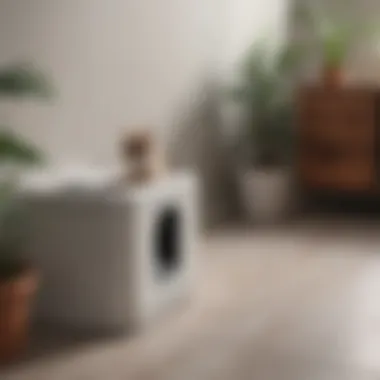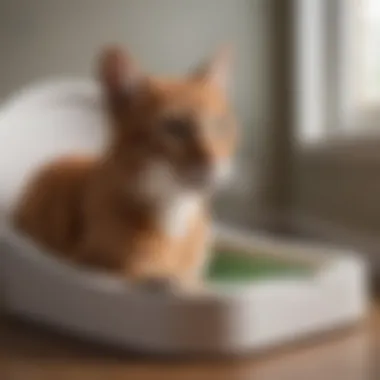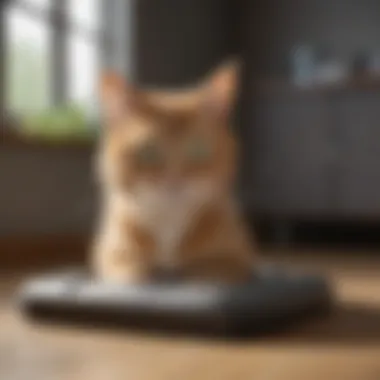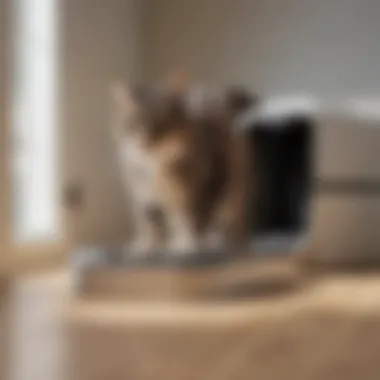Understanding Motion Sensor Litter Boxes: A Comprehensive Guide


Intro
Motion sensor litter boxes represent a significant advancement in pet care technology. They cater specifically to the needs of cat owners by streamlining the often tedious process of maintaining a clean litter environment. Understanding how these devices function, their benefits, and their drawbacks is crucial for anyone considering integrating them into their home. This guide will provide an in-depth look at the various models available, the underlying technology, and the overall impact on pet ownership and care.
Fascinating Facts About the Animal
Unique Characteristics
Cats are known for their unique behaviors and physiological traits. They possess keen senses, particularly in hearing and sight, allowing them to navigate their surroundings with agility. Their grooming behavior is also noteworthy; cats spend a significant portion of their day cleaning themselves. This affinity for cleanliness drives the necessity for efficient litter solutions, ultimately leading to the appeal of motion sensor litter boxes.
Extraordinary Abilities
Cats have impressive hunting instincts, which are rooted in their biology. For instance, they can see in low light due to a higher number of rod cells in their retinas. This ability to hunt and explore at night influences their natural litter habits. A motion sensor litter box respects these instincts by providing an automatic cleaning function, minimizing disturbance to a cat's routine.
Behavior and Habitat
Natural Habitats
Domestic cats are descended from wild feline ancestors that roamed diverse terrains, from forests to grasslands. Their ability to adapt helps them thrive in various environments, which can inform how a litter box should be designed. Features like enclosed spaces, depth, and adjustable settings can mimic their natural inclinations.
Social Structures
While cats are often perceived as solitary animals, they can form complex social structures when in groups. Their habits in using litter can reflect their social climate. A motion sensor litter box that caters to group dynamics can help maintain cleanliness and minimize territorial disputes among multiple cats.
Recent Scientific Discoveries
Latest Research Findings
Recent studies in feline behavior suggest that comfort plays a significant role in litter box usage. Research indicates that cats prefer clean, accessible boxes. Motion sensor technology responds to this need by automating the cleaning process. By ensuring that the litter is consistently fresh, these devices can positively influence a cat's willingness to use the bathroom properly.
Breakthroughs in Animal Biology
Innovations in veterinary science have led to advanced understanding of feline biology, specifically regarding their hygiene needs. Cats can develop health issues if exposed to dirty litter. With automated systems, motion sensor litter boxes help prevent such problems by maintaining an optimal environment.
Cultural Significance
Animals in Folklore
Cats have long held a significant place in cultural myths and folklore. From ancient Egyptian deities to various superstitions worldwide, their perception influences how society views their care. Emphasizing cleanliness through technology aligns with the longstanding respect for the feline's role in human culture.
Influence on Art and Literature
Throughout history, cats have inspired countless artworks and literary works. Their independent nature and grace have made them subjects of fascination. The development of smart pet care solutions, like motion sensor litter boxes, reflects ongoing innovation in improving the lives of these valued companions.
Motion sensor litter boxes are more than just a convenience; they signify a shift toward more responsible and responsive pet care in a rapidly evolving technological landscape.
By exploring these facets, readers can appreciate not only the functionality of motion sensor litter boxes but also the broader context of cat care.
Prologue to Motion Sensor Litter Boxes
Motion sensor litter boxes represent a significant advancement in pet care technology. Understanding these devices is crucial for pet owners who wish to optimize their cat's hygiene and convenience in litter management. As lifestyles become busier, the demand for effortless solutions in pet maintenance grows. Motion sensor litter boxes provide solutions that cater to both the needs of the cats and their owners, ensuring a cleaner and more pleasant environment.
Definition and Purpose
A motion sensor litter box is an automated device designed to detect the presence of a cat. Upon sensing movement, these boxes perform cleaning functions, allowing for a more sanitary environment without requiring manual intervention each time a cat uses it. The primary purpose of these products is to promote better hygiene by reducing the accumulation of waste and minimizing odors. This is particularly beneficial for households with multiple cats, where traditional litter boxes can become unpleasant quite quickly.
One of the essential features is the self-cleaning mechanism. When a cat exits the litter box, the sensors activate a cleaning cycle. This may involve raking through the litter to separate waste from clean litter or disposing of it entirely, depending on the model. This automated process not only saves time for owners but also helps in managing the health of the pet. Less contact with waste can lead to a reduction in the risk of exposure to bacteria and parasites.
Evolution of Litter Box Technology
The technology behind litter boxes has significantly evolved over the years. Initially, litter boxes were simple containers requiring regular manual cleaning. Traditional boxes often led to hygiene issues if the owner was busy or unable to maintain a consistent cleaning routine.


With advancements in technology, the introduction of self-cleaning mechanisms began to change the landscape of pet care. Devices like the ScoopFree Ultra Self-Cleaning Litter Box and the Litter-Robot became popular due to their innovative designs. These models used various sensor technologies to detect litter use and operate cleaning cycles automatically.
Today, newer versions of motion sensor litter boxes utilize sophisticated sensors and smart technology to enhance functionality. Some models connect to smartphone apps to provide real-time monitoring and status updates, allowing for seamless integration into modern pet ownership. This evolution reflects a broader trend towards automation in pet care, aligning with the ongoing advancements in smart home technology.
How Motion Sensor Litter Boxes Function
Motion sensor litter boxes are revolutionary in the field of pet care. Their functioning is crucial as it defines user experience and pet wellbeing. Understanding how these devices function can inform potential buyers and pet owners about the benefits and considerations that should be kept in mind.
Sensor Mechanisms
The heart of a motion sensor litter box lies in its sensor mechanisms. These sensors detect the presence of a cat approaching the box. Most often, infrared or pressure sensors are utilized. The infrared sensors use heat detection to identify an entering cat, while pressure sensors respond to weight changes on the box surface. These mechanisms ensure that the cleaning cycle initiates only when the cat has left the box, offering a clean environment for the next use.
- Types of Sensors: Common types include passive infrared (PIR) and pressure-sensitive pads.
- Importance of Timing: It is essential that sensors accurately time the cleaning processes to avoid disrupting the cat during its business.
Understanding these mechanisms is vital for assessing reliability and effectiveness of the litter box.
Automatic Cleaning Process
Once the cat departs, the automatic cleaning process is triggered. The litter box utilizes a rake or rotating system to sift through waste. This is a marked improvement over traditional boxes where manual cleaning is a daily chore.
- Efficient Waste Management: Many models have a timer that enforces a cleaning cycle, ensuring a consistent schedule.
- Litter Types Compatibility: Each model may be tailored for specific types of litter, influencing how well the waste is processed. For example, clumping clay litter is often preferred for its absorbent and mess-free qualities.
The automatic cleaning function significantly reduces the time spent by pet owners on maintenance tasks.
Power Sources and Efficiency
Power sourcing in motion sensor litter boxes can significantly influence performance. Most commonly, these devices operate on batteries or are plugged into the wall. The efficiency of power sources affects not only operational reliability but also cost in terms of energy consumption.
- Battery Life Considerations: Battery-operated models often have varying life spans. Choosing one with a longer battery life can reduce frequent replacements.
- Energy Efficiency: A well-designed motion sensor litter box will optimize power usage, minimizing waste of electricity. Some advanced models may even have solar options, although these are not yet universally available.
The connection between power sources and efficiency plays a crucial role in both ecological impact and overall user satisfaction.
Advantages of Using Motion Sensor Litter Boxes
Motion sensor litter boxes present several advantages that cater not just to the comfort of pets, but also offer significant benefits for their owners. Understanding these advantages is essential for anyone considering this technology for their feline companions. Key elements include enhanced hygiene, convenience for pet owners, and a noticeable reduction in odor. Each of these benefits contributes to a more efficient and pleasant living environment.
Enhanced Hygiene
The hygiene aspect of motion sensor litter boxes is one of the primary advantages of adopting this technology. Traditional litter boxes often require regular scooping and maintenance to ensure cleanliness. This can become a tedious task for many pet owners. Motion sensor models, with their automatic cleaning features, can provide a significant improvement in litter box cleanliness.
Automatic cleaning processes activate shortly after the pet exits the box, effectively removing waste and minimizing the chances of bacteria spread. The technology ensures that the litter is regularly sifted or cleaned, reducing the accumulation of waste. Owners can thus have peace of mind knowing that their pets have a cleaner environment to use.
Convenience for Pet Owners
In the pursuit of convenience, motion sensor litter boxes serve as a welcome solution to the daily chores of pet ownership. The self-cleaning capability allows owners to spend less time maintaining a litter box and more time engaging with their pets. This is particularly valuable for busy individuals or families balancing various responsibilities.
Many models include notification systems that alert owners when the box has completed a cleaning cycle or when more litter is necessary. This feature allows for a seamless integration into daily routines without constant monitoring. Ultimately, the reduced workload can contribute to an overall improved pet care experience.
Reduction in Odor
Odor control is a significant concern in maintaining a household with cats. Traditional litter boxes can become a source of unpleasant smells, particularly if not cleaned regularly. Motion sensor litter boxes can significantly reduce odor through their automatic mechanisms and advanced litter management systems.
By promptly removing waste after use, these boxes help to minimize the time that feces and urine linger in the litter. Many models utilize odor-absorbing and clumping litters that further combat any potential smells. As a result, households often find that the air quality improves, contributing to a more pleasant living space.
"Investing in a motion sensor litter box not only improves hygiene and convenience but also effectively addresses odor issues that often plague traditional methods."
Overall, the advantages of motion sensor litter boxes highlight the transformation in pet care technology. These benefits resonate with owners who seek cleanliness and convenience while attending to their pets' needs.
Potential Limitations and Drawbacks
Motion sensor litter boxes represent a significant advancement in pet care technology. However, potential limitations exist that are crucial for prospective buyers to consider. Understanding these drawbacks will aid cat owners in making informed decisions. Evaluating limitations involves analyzing costs, maintenance needs, and how pets respond to these devices.


Initial Costs and Investment
One primary concern with motion sensor litter boxes is the initial cost. Compared to traditional litter boxes, which can be purchased for a modest price, motorized versions often come with a hefty sticker price.
A typical motion sensor litter box can range from $100 to several hundreds of dollars. This high entry price can deter buyers, especially if they are uncertain about the long-term benefits or practicality for their specific situation.
It is important to recognize that while the upfront costs may be intimidating, these boxes could yield savings in maintenance over time. Thus, potential buyers should weigh both the upfront investment and long-term cost benefits. A careful calculation is needed, considering the cleanliness and convenience that these devices provide.
Maintenance and Cleaning Concerns
Despite the automatic features designed to ease the cleaning burden, motion sensor litter boxes still require maintenance. Owners need to regularly check and clean sensor components to ensure optimal functionality. Failure to do so may result in malfunction or decreased responsiveness of the sensors.
Furthermore, while these boxes automate many processes, the litter tray still needs to be emptied and refilled. This aspect can be a disappointment for those expecting full automation. If not properly maintained, there can be unfortunate mishaps, which can lead to unsanitary conditions.
Sensitivity Issues with Pets
Some pets might take time to adapt to motion sensor litter boxes. Felines, in particular, can be sensitive to new experiences. Loud noises generated by the motor or sudden movements may frighten them. It is essential for pet owners to consider their individual cat’s personality and behavior before making a purchase. Some pets may refuse to use boxes that they find intimidating.
In extreme cases, this can result in litter box avoidance entirely, causing significant issues for both the cat and its owner. This apprehension highlights the importance of appropriate socialization and gradual acclimatization to technology.
Popular Models on the Market
Understanding the various motion sensor litter boxes available can significantly influence the decision-making process for pet owners. Each model brings its own features, usability, and benefits, which are essential to consider for optimal feline care. This section examines prominent models, its features, and how they cater to the diverse needs of consumers.
Brand Comparisons
When comparing brands, it is imperative to look at how each one approaches technology and behavioral adaptations in pets. Brands like PetSafe, Litter-Robot, and CatGenie have established themselves as leaders in this market.
- PetSafe: Known for its affordability and reliability. Their motion sensor litter boxes are designed for easy setup and regular use.
- Litter-Robot: Offers advanced technology with an automatic cleaning cycle after each use. It is often seen as a premium option due to its build quality and innovative features.
- CatGenie: Unique in that it offers a self-washing litter box, which eliminates the need for traditional litter. It integrates with plumbing systems, making it a niche but desirable choice.
Each brand has unique strengths. Potential buyers should assess their preferences regarding price, technology features, and maintenance commitments before making a choice.
Feature Analysis
Features are vital as they directly impact user experience and pet comfort. Here are key aspects to consider across popular models:
- Sensor Precision: The accuracy of motion detection can vary. Higher precision sensors minimize false triggers and ensure that pets can use the box without unnecessary interruptions.
- Cleaning Mechanism: Models vary from raking mechanisms to full cleaning cycles. Understanding how often and efficiently each option cleans itself is crucial for maintaining hygiene.
- Size and Design: Availability in various sizes accommodates different cat breeds and sizes, while modern aesthetics can complement home decor.
- Connectivity: Some devices offer smartphone applications for maintenance reminders and usage tracking. This can enhance convenience for tech-savvy pet owners.
Analyzing these features helps narrow down options to those that best suit individual user needs.
Consumer Reviews and Feedback
Feedback from actual users provides valuable insights into the practicality and performance of these models. Reviews often highlight important user experiences and reliability factors:
- Positive Feedback: Many consumers report enhanced hygiene and less frequent cleaning times. When a litter box operates smoothly, it can significantly reduce stress for both pets and owners.
- Negative Feedback: Common critiques include issues with sensors malfunctioning or needing repairs over time. Higher-end models sometimes come with a learning curve related to their usage and connectivity features.
It is important for prospective buyers to monitor these reviews across platforms like Reddit and Facebook to get a balanced perspective.
Integrating Motion Sensor Litter Boxes in Pet Care
Integrating motion sensor litter boxes into pet care represents a significant advancement in feline hygiene and owner convenience. These devices not only streamline the cleaning process but also promote better health for cats by encouraging regular use and reducing the risk of urinary tract infections. It is important to understand how to effectively incorporate these litter boxes into existing routines for optimal benefits.
Training Pets to Use Technology
Introducing a motion sensor litter box to a cat may require some training. Unlike traditional litter boxes, these newer models can be intimidating. Here are some strategies for ensuring a smooth transition:
- Gradual Introduction: Start by placing the new litter box in the same location as the old one. Allow the cat to explore it without the sensor activation for a few days.
- Positive Reinforcement: Reward the cat with treats or affection each time it uses the new box. This builds a positive association with the technology.
- Monitor Behavior: Watch for signs of hesitation or confusion. If the cat appears anxious around the motion sensor, consider temporarily disabling the automation until it gets used to the change.
Training pets to adapt can enhance the effectiveness of the motion sensor litter box, ensuring it meets the specific needs of both the animal and the owner.
Combining with Other Pet Care Devices


Motion sensor litter boxes can work harmoniously with other pet care devices, enhancing their functionality. For example:
- Automated Feeding Systems: Synchronizing the litter box with an automatic feeder can help align feeding schedules and bathroom breaks, potentially reducing accidents.
- Monitoring Systems: Some advanced models come equipped with sensors that can monitor a pet's health by tracking usage patterns. This data can then be relayed to mobile apps for better management of a cat's well-being.
- Environment Control: Integrating litter boxes with smart home technology can automate room temperature or lighting, making the area more comfortable for the cat.
The combination of advanced technology fosters a cohesive environment that addresses the comprehensive needs of pets.
Adjusting Household Routines
Transitioning to a motion sensor litter box may necessitate some adjustments in household routines. Consider these aspects:
- Cleaning Schedule: Even with automated features, it may be necessary to establish a regular cleaning schedule. This includes emptying the waste container or replacing the litter to maintain hygiene.
- Routine Check-ins: Regularly check on the litter box to ensure it is functioning effectively. This can prevent minor malfunctions from becoming bigger issues.
- Involvement of All Family Members: Make sure everyone in the household understands how the system works, including older children or caregivers. This ensures that the litter box is treated with respect and maintained properly.
Adjusting to these new routines will maximize the benefits of a motion sensor litter box, ensuring both the cats' and owners' needs are met.
In summary, integrating motion sensor litter boxes into pet care involves thoughtful strategies for training pets, utilizing complementary devices, and adjusting household routines. This not only improves hygiene but also enhances the overall well-being of feline family members.
Future Trends in Litter Box Technology
The landscape of pet care technology is rapidly evolving, with litter boxes being no exception. Understanding the future trends in litter box technology is crucial for those looking to invest in these innovations. This section explores emerging technologies and their potential implications for cat owners.
Innovations on the Horizon
Innovative solutions are consistently introduced into the market. These solutions cater to both the needs of pets and their owners. One significant trend is the incorporation of artificial intelligence into litter boxes. This technology can monitor cat behaviors to provide insights into their health.
Another area of advancement is the improvement in self-cleaning mechanisms. While current models do a decent job, future iterations are likely to employ advanced materials that can better control odors and require less frequent cleaning. For example, boxes may use specialized liners that break down waste more effectively, promoting hygiene.
Moreover, designs will likely focus on reducing noise and enhancing the overall user experience. Many pet owners find noise from current models disruptive. Therefore, quieter mechanisms will be highly sought after.
Key Innovations Expected:
- Artificial Intelligence for behavioral monitoring
- Advanced self-cleaning technologies
- Quieter operation mechanisms
- Improved materials for odor control
The Role of Smart Technology
Smart technology is increasingly becoming integral to pet care devices. Motion sensor litter boxes, combined with smart technology, have the potential to create a comprehensive care system for pets. Future designs may allow connectivity to mobile apps, enabling real-time monitoring of a cat's litter box habits, even from afar.
This data can help owners understand their cat's health better. For instance, if a cat consistently avoids the litter box, it could indicate a health issue. Notifications sent directly to the owner's phone could prompt timely visits to the veterinarian, facilitating early intervention.
Furthermore, integration with home automation systems is anticipated. This allows for features such as automatic litter box cleaning scheduled during quiet hours, further minimizing disturbances in the home. The aesthetic consideration of these devices will also improve, as they will blend seamlessly with modern home decor.
Advancements Expected with Smart Technology:
- Mobile app connectivity for monitoring actions
- Notifications for abnormal behaviors
- Integration with home automation systems
- Improved aesthetic designs
The future of litter box technology promises enhanced features that will significantly improve both pet and owner satisfaction while promoting better health insights.
In summary, the future trends in litter box technology indicate a move toward smarter, quieter, and more efficient products. Embracing these innovations can improve pet care while simplifying the responsibilities of pet ownership.
Ending: Evaluating the Role of Motion Sensor Litter Boxes
Motion sensor litter boxes represent a significant advancement in pet care technology. Their ability to enhance hygiene and simplify maintenance reflects changing expectations in feline ownership. As discussed throughout the article, the convenience they offer can greatly impact the daily routines of pet owners, providing a cleaner and more manageable environment for both the cat and the caretaker.
The technology of these devices goes beyond mere functionality. With automatic cleaning processes and built-in sensors, they provide a thoughtful solution to common pet ownership challenges. Considering their role within a household, motion sensor litter boxes can greatly contribute to a better quality of life for both pets and their owners.
"The integration of smart technology into pet care has redefined expectations and standards, urging pet owners to rethink traditional methods."
Final Thoughts on Utility and Reliability
Assessing the utility of motion sensor litter boxes involves recognizing their role in modern pet care. They offer consistent and reliable performance, significantly reducing the manual effort required for maintaining clean litter. Moreover, these devices often include specialized features that enhance their reliability, such as notifications and troubleshooting options. For many pet owners, the transition to a motion sensor litter box can feel intuitive and rewarding.
Besides, the reliability of motion sensor technology continues to improve. Users often find that these products can keep their homes cleaner while minimizing odors. The adjustments these devices make with everyday use lead to a more user-friendly experience, which is valuable in a busy household.
Considerations for Potential Buyers
Despite the clear benefits, potential buyers should still approach this technology with a degree of caution. Here are some specific factors to consider before making a purchase:
- Initial Investment: Motion sensor litter boxes can have a higher upfront cost compared to traditional options. Evaluating whether the long-term benefits justify this expense is crucial.
- Compatibility with Pets: Some cats may take time to adjust to automated features. Understanding your pet’s behavior is important before transitioning.
- Maintenance Requirements: While these devices reduce manual cleaning, they still require periodic maintenance. Maintaining sensors and ensuring optimal operation is essential for utility.
- Technology Lifespan: Like any technological device, consider the expected lifespan and warranty options. Knowing the potential for malfunctions or repairs can affect the overall ownership experience.







